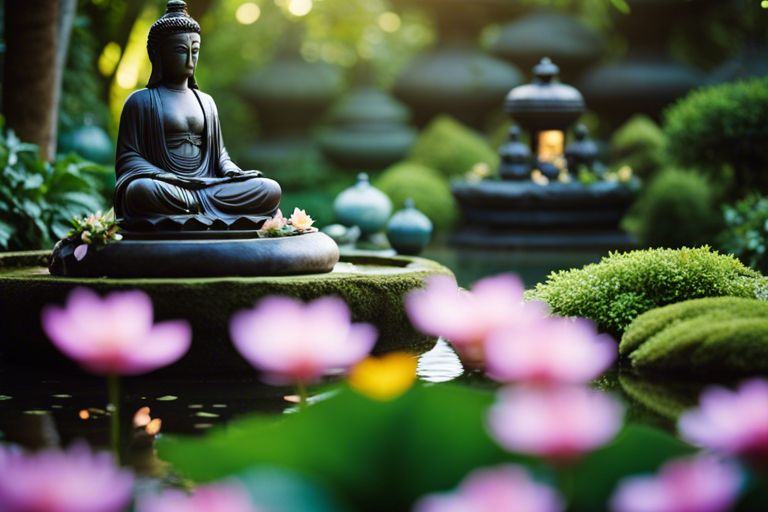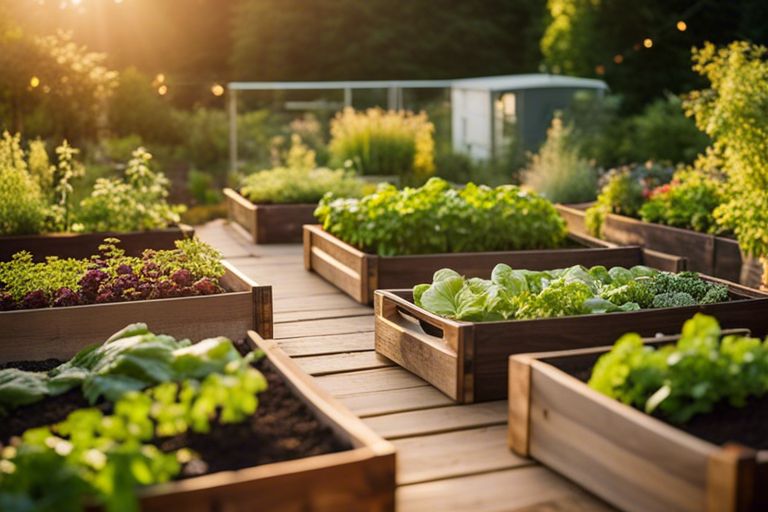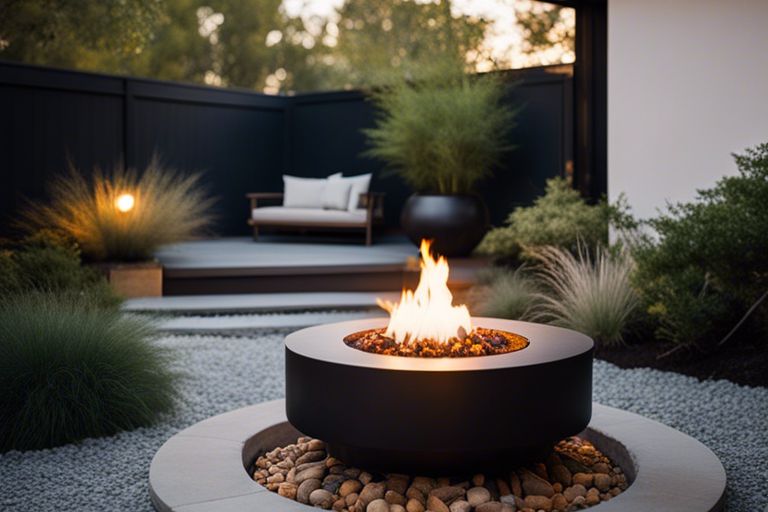21 Best Spiritual Garden Ideas

Tranquility is achieved when we connect with nature and create a sacred space in our own garden.
In this post, I will guide you through 21 best spiritual garden ideas that will help you cultivate inner peace and harmony in your outdoor sanctuary.
From Zen rock gardens to meditation labyrinths, these spiritual garden ideas will inspire you to create a space that nurtures your soul and brings you closer to the divine.
Let’s begin on this journey of creating a sacred oasis where your spirit can thrive.

Creating a Sacred Space

Before submerging into the creation of your spiritual garden, it’s important to take a moment to define your intentions for this sacred space.
What do you hope to achieve in this garden? What feelings or energies do you want to cultivate?
Whether it’s peace, tranquility, healing, or connection with nature, setting a clear intention will guide the design and atmosphere of your spiritual garden.
Spiritual Intentions
Spiritual intentions set the tone for your garden and influence the selection of elements you may choose to include.
Consider creating a quiet space for reflection and meditation, or perhaps incorporating plants and flowers that have personal or symbolic significance to you.
By infusing your garden with intention, you can create a deeply meaningful and harmonious sanctuary.
Choosing a Location for Your Garden

Sacred gardens thrive in locations that resonate with your spiritual goals. Look for a spot in your yard that receives ample sunlight and is shielded from noisy distractions.
Ideally, you want a space that allows you to feel a sense of seclusion and connection to the earth.
Choosing a location is a crucial step in creating a space that supports and nourishes your spiritual practice.
Your sacred garden should be a place that inspires tranquility and reflection. Consider environmental factors such as wind patterns, proximity to trees or bodies of water, and the overall energy of the space.
By carefully selecting a location that aligns with your intentions, you can cultivate a spiritual oasis that serves as a personal retreat for the soul.

Elements of a Spiritual Garden

The essence of a spiritual garden lies in creating a harmonious space that connects you with nature, the universe, and your inner self.
There are several key elements that can help you cultivate this sacred sanctuary in your outdoor space.
Incorporating Nature’s Wonders
The first step in creating a spiritual garden is to immerse yourself in nature’s wonders. Surround yourself with **trees**, **flowers**, and **plants** that resonate with your soul. **Bird feeders** and **birdbaths** can attract beautiful creatures that bring a sense of peace and joy to your garden.
Using Color and Texture to Inspire
Any garden can be transformed into a spiritual oasis by using **color** and **texture** mindfully.
**Soft pastel hues** like **lavender** and **light blue** can evoke a sense of calm, while **rough stone paths** and **smooth pebbles** can add depth and grounding to your space.
Texture: Incorporating different textures like **rough stones**, **smooth pebbles**, and **velvety moss** can create a sensory experience that soothes the mind and invigorates the spirit.
By engaging multiple senses, you can deepen your connection to the present moment and feel more in tune with nature.
The Power of Water Features
Elements of water, such as **fountains**, **reflecting pools**, or **streams**, can enhance the spiritual energy of your garden. The soothing sound of flowing water can quiet the mind, while the glistening surface can symbolize clarity and reflection.
A: Water features are not just visually appealing but also have a profound spiritual significance. The continuous flow of water represents the impermanence of life and the constant change in our existence.
Incorporating water elements in your garden can serve as a reminder to embrace change and find peace in the ebb and flow of life.
Planting for Spiritual Growth

Selecting Plants with Spiritual Significance
Growth To cultivate a spiritually nourishing garden, it’s important to choose plants that hold special significance for you.
Whether it’s a flower that symbolizes peace, a herb known for its healing properties, or a tree that represents strength, selecting plants with spiritual meaning can enhance your connection to nature and your inner self.
Cultivating Mindfulness through Gardening
Mindfulness In the act of tending to your garden, you have the opportunity to practice mindfulness and live in the present moment.
As you water your plants, pull weeds, and nurture your garden, you can fully engage your senses and appreciate the beauty of nature surrounding you.
This mindful approach to gardening can help you find peace and clarity amidst life’s distractions.
Plus Engaging in mindful gardening not only benefits your plants but also your overall well-being.
By grounding yourself in the present moment and focusing on the task at hand, you can reduce stress, improve mental clarity, and cultivate a sense of gratitude for the abundance of nature.
The Role of Herbs in Spiritual Practices

To Herbs have long been revered for their spiritual properties and healing qualities.
From smudging rituals with sage to brewing calming teas with lavender, herbs play a significant role in many spiritual practices around the world.
By incorporating these sacred plants into your garden, you can create a sacred space for meditation, reflection, and connection to the divine.
Plants Herbs like sage, rosemary, and lavender are not only aromatic additions to your garden but also powerful tools for spiritual growth.
Sage is traditionally used for cleansing and purifying energy, while rosemary is associated with memory and protection.
Lavender, known for its calming properties, can help you relax and unwind after a long day. Including these herbs in your spiritual garden can deepen your spiritual practice and enhance your overall well-being.
Designing for Meditation and Reflection

Creating a Peaceful Atmosphere
Reflection. Now, to create a spiritual garden space that is ideal for meditation and reflection, it is crucial to cultivate a peaceful atmosphere.
Incorporate elements like flowing water features, such as a fountain or a small pond, to create a soothing and calming environment.
Surround yourself with plants that have calming scents like lavender, jasmine, or rosemary. These fragrances can help you relax and center your mind during meditation.
Incorporating Statues and Sculptures
Statues. When designing a garden for meditation and reflection, incorporating statues and sculptures can be a powerful way to enhance the spiritual ambiance.
Choose statues of spiritual figures or symbols that hold personal significance to you, such as Buddha, Quan Yin, or angels.
These statues can serve as focal points for your meditation practice, helping you to connect with higher energies and deepen your reflection.
Atmosphere. Statues and sculptures can add a sense of sacredness and reverence to your garden, creating a space that feels sacred and serene.
Choose statues made of materials like stone or bronze, as these natural elements can help ground the energy of your garden and provide a sense of stability and peace.
Using Lighting to Set the Mood
For creating a spiritual garden that is conducive to meditation and reflection, consider using lighting to set the mood.
Soft, warm lighting like candles or fairy lights can create a cozy and intimate atmosphere perfect for quiet contemplation.
Place lanterns along pathways or around seating areas to illuminate your garden gently.
Plus, lighting can also symbolize the inner light that we all possess, guiding us through moments of darkness and helping us find our way back to ourselves.
Experiment with different lighting options to see what resonates with you and enhances your spiritual practice in the garden.
Incorporating Spiritual Symbols and Icons

Many spiritual gardens incorporate symbols and icons that hold deep meanings and significance.
These elements not only add beauty to the garden but also serve as powerful reminders of spiritual teachings and values.
The Meaning Behind Mandalas and Labyrinths
Icons such as mandalas and labyrinths are often used in spiritual gardens to represent the journey towards enlightenment and self-discovery.
**Mandalas** are circular designs that symbolize the universe, unity, and harmony.
**Labyrinths** are intricate pathways that lead to a center point, symbolizing the journey inward towards one’s true self. Walking a labyrinth can be a meditative practice, helping to calm the mind and focus on inner peace.
Using Crystals and Gemstones for Energy
Icons like **crystals and gemstones** are believed to possess healing and energy-enhancing properties.
In a spiritual garden, incorporating crystals and gemstones can help balance the energy flow and create a harmonious environment.
Each crystal carries its own unique energy, so you can choose specific stones based on your intentions.
Placing crystals strategically throughout your garden can amplify the positive energy and bring a sense of tranquility to the space.
Icons such as **crystals and gemstones** can act as focal points in your garden, inviting you to pause, reflect, and connect with their calming energies.
Whether placed in a dedicated crystal grid or scattered throughout the garden, these natural elements can enhance the spiritual atmosphere and promote a sense of well-being.
The Significance of Buddha Statues and Other Icons
**Symbols** like Buddha statues and other spiritual icons are commonly found in gardens dedicated to mindfulness and inner peace.
Buddha statues, for example, represent enlightenment, compassion, and inner wisdom. Including these **icons** in your garden can serve as a visual reminder to cultivate these qualities within yourself.
By creating a sacred space adorned with meaningful symbols, you can deepen your spiritual practice and create a sanctuary for reflection and meditation.
**Spiritual** **icons** like Buddha statues carry a sense of tranquility and serenity, infusing your garden with their peaceful presence.
Placing these symbols strategically in your garden can help you center your mind and heart, bringing a sense of calm amidst the beauty of nature.
Incorporating **spiritual symbols and icons** into your garden can elevate its energy and create a space that nurtures your soul.
By intentionally selecting elements that hold personal meaning and significance, you can design a spiritual oasis that inspires and uplifts you daily.

Nurturing Your Spiritual Garden

Not only does tending to your garden improve the physical health of your plants, but it also nourishes your soul.
When I care for my plants mindfully, I am engaging in a spiritual practice that allows me to connect deeply with nature and cultivate a sense of peace and tranquility within myself.
Caring for Your Plants as a Spiritual Practice
Spiritual gardening involves approaching the care of your plants with intention and mindfulness.
As I water my garden, prune the leaves, and remove weeds, I do so with a sense of gratitude and reverence for the life that I am nurturing.
This practice not only helps me connect with the present moment but also fosters a sense of care and compassion for all living beings.
Seasonal Rituals and Celebrations
Rituals play a significant role in spiritual gardening, allowing you to mark the changing seasons and celebrate the cycle of life.
I find that honoring the solstices, equinoxes, and other seasonal transitions in my garden helps me stay attuned to the natural rhythms of the earth and fosters a sense of harmony and balance in my life.
Your garden can become a sacred space where you can engage in rituals that honor nature and the divine.
Whether you choose to meditate under a full moon, plant seeds on the first day of spring, or create a labyrinth for walking meditation, these rituals can deepen your connection to the earth and cultivate a sense of spiritual well-being.
Inviting Nature’s Creatures into Your Garden
Any garden is an ecosystem teeming with life, not just plants but also insects, birds, and other creatures.
When I invite these beings into my garden, I am creating a harmonious environment where all living beings can thrive together.
Watching a butterfly flutter among the flowers or listening to the birds sing brings me immense joy and reminds me of the interconnectedness of all life.
Your garden can become a sanctuary for a variety of creatures, providing food, shelter, and a safe haven for them to live and thrive.
By welcoming wildlife into your garden, you are not only enhancing its biodiversity but also deepening your connection to the natural world.
Final Words
Considering all points, I hope these 21 spiritual garden ideas have inspired you to create a sacred space that not only nurtures your plants but also rejuvenates your mind, body, and soul.
Do not forget, your garden can be a reflection of your inner peace and spirituality, guiding you towards mindfulness and serenity in your daily life.






